Tkuze
Hazard to Others
  
Posts: 108
Registered: 8-5-2019
Member Is Offline
|
|
Advice on best bottles for 98% HNO3
Hey guys,
I wanted some advice on what you find to be the best container for longterm storage of nitric acid. I have amberglass bottles with green PTFE coated
caps, but i just checked in the fridge and one cap was yellow and leaking and basically destroyed. The other bottle had the cap perfectly in shape. I
have a 1L aldrich bottle to hold a majority of it, but never use it to pour directly because it tends to want to not pour out perfectly into the grad
cylinder. Any advice would be helpful. Im guessing maybe one of the green coated bottle caps was already compromised or something. I can post pics if
needed
|
|
|
Tkuze
Hazard to Others
  
Posts: 108
Registered: 8-5-2019
Member Is Offline
|
|
Pic
Pic
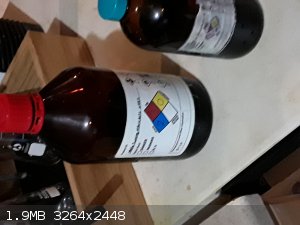 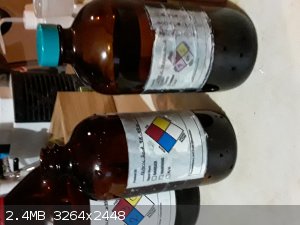
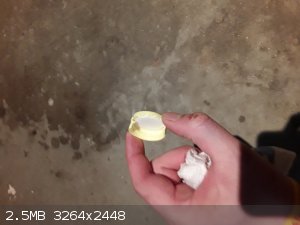 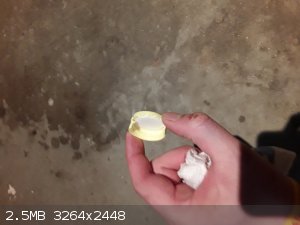 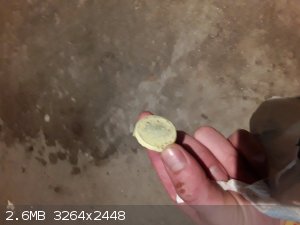
|
|
|
Tkuze
Hazard to Others
  
Posts: 108
Registered: 8-5-2019
Member Is Offline
|
|
Just to clarify, the green bottle cap on the amber glass bottle is the same as the destroyed yellow one( or at least they started out identical)
|
|
|
Sulaiman
International Hazard
    
Posts: 3554
Registered: 8-2-2015
Location: 3rd rock from the sun
Member Is Offline
|
|
I kept fuming nitric in a sauce bottle for two years with no problem,
http://www.sciencemadness.org/talk/viewthread.php?tid=90897
but generally it is best to make it just before you need it.
CAUTION : Hobby Chemist, not Professional or even Amateur
|
|
|
monolithic
Hazard to Others
  
Posts: 435
Registered: 5-3-2018
Member Is Offline
Mood: No Mood
|
|
The green caps have a soft PTFE disc in them, right? I'm surprised that they leaked if the lid was tightened.
|
|
|
Tkuze
Hazard to Others
  
Posts: 108
Registered: 8-5-2019
Member Is Offline
|
|
Yeah i think this is rhe second cap that went bad. I lept the threading dry and clean and used parafilm to seal it. I really think it has some outside
damage or small defect that allowed it to escape and eat the surrounding plastic. Its strange because the other cap is in perfect condition
|
|
|
Keras
National Hazard
   
Posts: 766
Registered: 20-8-2018
Location: (48, 2)
Member Is Offline
|
|
I’d probably keep nitric acid in one of those old vintage glass bottles with glass stoppers former pharmacists used. You can find a few ones on
eBay, and some even have”nitric acid” engraved on them!
|
|
|
Tkuze
Hazard to Others
  
Posts: 108
Registered: 8-5-2019
Member Is Offline
|
|
Apocethary bottles! Yeah ill have to get amber glass ones.
|
|
|
Cezium
Harmless

Posts: 39
Registered: 5-1-2015
Member Is Offline
Mood: No Mood
|
|
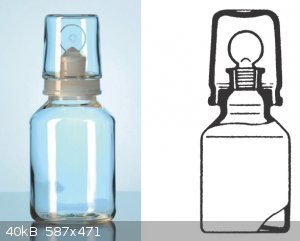
|
|
|
Herr Haber
International Hazard
    
Posts: 1236
Registered: 29-1-2016
Member Is Offline
Mood: No Mood
|
|
Quote: Originally posted by Tkuze  | Yeah i think this is rhe second cap that went bad. I lept the threading dry and clean and used parafilm to seal it. I really think it has some outside
damage or small defect that allowed it to escape and eat the surrounding plastic. Its strange because the other cap is in perfect condition
|
That happened to me because the pouring ring still had a small barb on it from manufacture. Vapors seeped through the space between the barb and the
PTFE from the cap and ate the cap.
I now remove the pouring rings and use PTFE caps (not just a liner) with a conical seal.
The conical seal is only needed for things that are going to build up pressure.
|
|
|
draculic acid69
International Hazard
    
Posts: 1371
Registered: 2-8-2018
Member Is Offline
|
|
Would a coke bottle not stand up to the hno3?
[Edited on 23-5-2019 by draculic acid69]
|
|
|
Herr Haber
International Hazard
    
Posts: 1236
Registered: 29-1-2016
Member Is Offline
Mood: No Mood
|
|
Not for long
https://www.plasticsintl.com/chemical-resistance-chart
|
|
|
draculic acid69
International Hazard
    
Posts: 1371
Registered: 2-8-2018
Member Is Offline
|
|
That list says sulfuric acid is fine with no rxn for PET.ive seen h2so4 seem fine at first but an HR later it started smoking and heating up and
dissolved it's way out of the bottle and all over everything.it fucks with PET bottles.now that I think about it it was moflo drain cleaner with 10%
dmso.dont know whether that makes a difference or not.
|
|
|
Keras
National Hazard
   
Posts: 766
Registered: 20-8-2018
Location: (48, 2)
Member Is Offline
|
|
There’s quite a comprehensive references on various plastic resistance to a lot of chemicals here.
[Edited on 23-5-2019 by Keras]
|
|
|
FloridaAlchemist
Hazard to Self
 
Posts: 76
Registered: 8-6-2003
Location: USA
Member Is Offline
Mood: No Mood
|
|
Nitric Acid Storage Bottle
A common BOD glass stoppered bottle works well to store fuming nitric acid.
|
|
|
Dragonjack12
Harmless

Posts: 25
Registered: 24-5-2018
Location: Northern Minnesota
Member Is Offline
Mood: Chlorine trifloride
|
|
You can by little PTFE stoppers on amazon that might fit on your bottle. It would probably be temporary but then your prepared for a future Incident
too,
Jack place
|
|
|
Tkuze
Hazard to Others
  
Posts: 108
Registered: 8-5-2019
Member Is Offline
|
|
Thanks so much for your help. Ill look on amazon
|
|
|
sbreheny
Hazard to Others
  
Posts: 145
Registered: 30-1-2014
Member Is Offline
Mood: No Mood
|
|
I want to second the suggestion of the glass bottle with ground glass stopper. That's what I use (see first two photos). One caveat is that the
bottle will develop a slight positive pressure, lift the glass stopper slightly, and allow some fumes to escape. You might be able to prevent this by
using a Keck clip but I haven't tried.
At first I used FEP (highly chemical resistant, similar to Teflon) bottles, and they DO work, but I found that they are slightly permeable to HNO3
vapor AND they took on a frosted appearance after a while. I'm not sure if this is a direct result of HNO3 or if it is actually ammonium nitrate
crystals deposited inside the plastic (it was stored near ammonia and would slowly develop ammonium nitrate crystals on the outside of the bottle). My
last photo here shows two identical FEP bottles - one which was used to store fuming nitric acid and the other unused.
Regarding the melamine caps with the Teflon liner - I have used those on bottles of 70% HNO3 and it always degrades them eventually. I think it is a
combination of the fact that HNO3 vapor hits them when you open and close the bottle, some HNO3 often remains on the lip of the neck of the bottle
when you close them, and also I suspect that like FEP, PTFE is slightly permeable to HNO3 (even though it isn't attacked by it)
By the way, my HNO3 started out at 94% (measured by density) and very pale yellow, and has over the last 3.5 years partially decomposed so that there
is dissolved NO2 in it, as you can see. It would be nice if the ground-glass stoppered acid bottle were made from dark glass as I think that reduces
the decomposition rate.
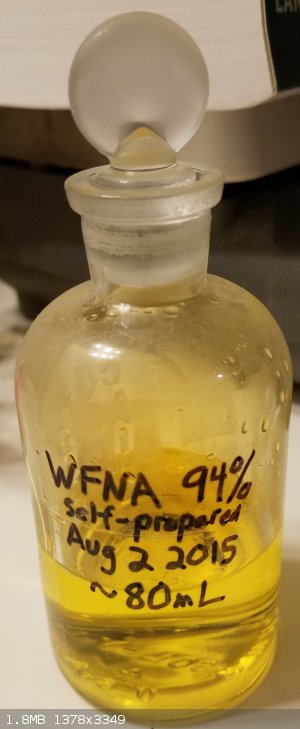 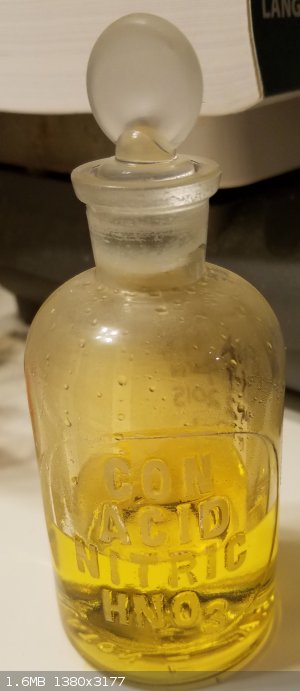 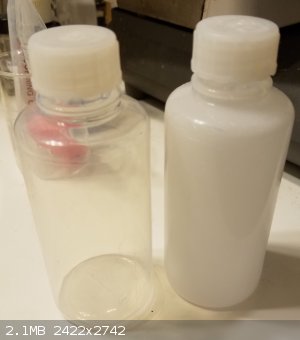
|
|
|